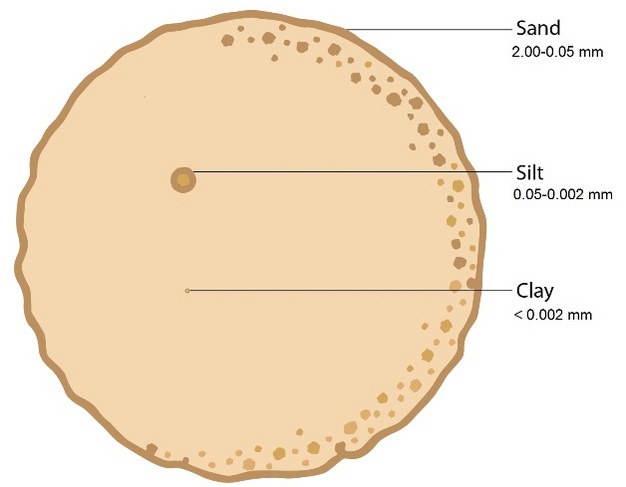« Prev Next »
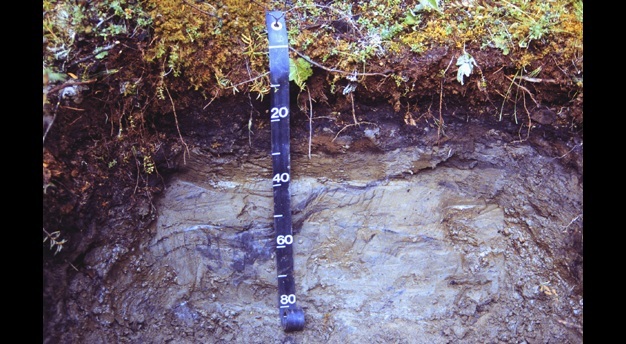
Soils are dynamic and diverse natural systems that lie at the interface between earth, air, water, and life. They are critical ecosystem service providers for the sustenance of humanity. The improved conservation and management of soils is among the great challenges and opportunities we face in the 21st century.
Soil is... a Recipe with Five Ingredients
Soil is a material composed of five ingredients — minerals, soil organic matter, living organisms, gas, and water. Soil minerals are divided into three size classes — clay, silt, and sand (Figure 1); the percentages of particles in these size classes is called soil texture. The mineralogy of soils is diverse. For example, a clay mineral called smectite can shrink and swell so much upon wetting and drying (Figure 2) that it can knock over buildings. The most common mineral in soils is quartz; it makes beautiful crystals but it is not very reactive. Soil organic matter is plant, animal, and microbial residues in various states of decomposition; it is a critical ingredient — in fact the percentage of soil organic matter in a soil is among the best indicators of agricultural soil quality (http://soils.usda.gov/sqi/) (Figure 3). Soil colors range from the common browns, yellows, reds, grays, whites, and blacks to rare soil colors such as greens and blues.

Soils are... Big
You may be surprised to hear "dirt" described as "big". However, in the late 1800's soil scientists began to recognize that soils are natural bodies with size, form, and history (Figure 4). Just like a water body has water, fish, plants, and other parts, a soil body is an integrated system containing soil, rocks, roots, animals, and other parts. And just like other bodies, soil systems provide integrated functions that are greater than the sum of their parts.
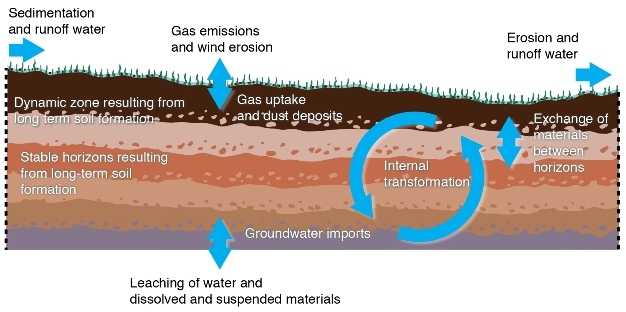
One is usually able to distinguish different layers within soils, called soil horizons (Figure 5). These horizons interact with each other, and therefore cannot be considered as independent, although they can be very different from each other. There is great complexity and diversity in soil horizons, but in general the surface horizons are dynamic and rich in life and organic matter. Below the surface horizons, one often finds more stable horizons that are formed through a diverse suite of soil formation processes, such as bright white horizons formed through the removal of clays or deep-red, low-fertility horizons formed through millions of years of weathering (Figure 6). Below these horizons, soils transition into layers that are only partially affected by soil formation and ultimately into unaltered layers of parent material.
The lateral extent of a soil can be difficult to define because adjacent soils can have sharp to gradual transitions. Soil bodies can be conceptualized and mapped at different scales, for example for an individual property or an entire watershed. The characterization and delineation of soil bodies forms the basis of most soil mapping systems (Figure 7).
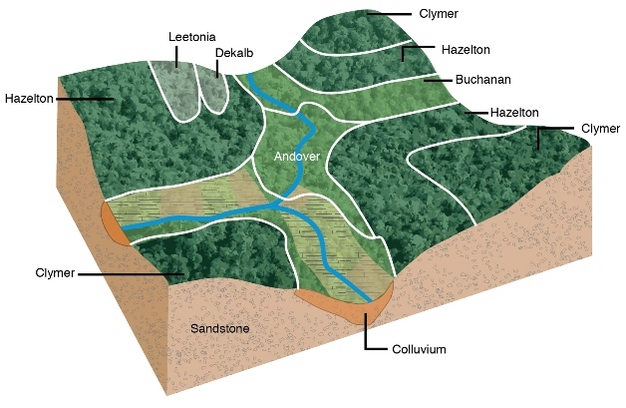
Soils are... Young to Very, Very Old
It can be difficult to say exactly when some soils were born, but we can say that while some are young, many are very old. The oldest soils on earth may be in Australia, where stable land forms have allowed some soils to age several million years. New soils are born with every landslide, volcanic eruption, or glacial retreat. Soils change over time through a host of biological, chemical, and physical processes. Horizons form, minerals and rocks weather, nutrients leach, and plant communities change. Soil scientists have learned to predict the current stage of these processes if given five key pieces of information about the soil's history — the five factors of soil formation — climate, organisms, topography, parent material, and time (Jenny 1941).Soils are... Diverse
The variety of soil formation processes operating on different parent materials under different climatic, topographic, and biological conditions over varying periods of time gives rise to the vast diversity of soils on earth. Soil formation creates a dizzying array of soil horizons; here are just a few examples:- Plinthite — which hardens irreversibly upon repeated wetting and drying (Figure 8a).
- Sulfidic — a horizon containing pyrite which, upon exposure to oxygen, can produce so much sulfuric acid that it kills plants and can cause fish kills (Figure 8b).
- Petrocalcic — in which so much calcium carbonate is accumulated that it literally forms a rock-like layer in the middle of a soil (Figure 8c).

Soils... Communicate
These master horizons may then be further annotated to give additional information about the horizon. Horizons are first assigned to one of the following master horizons as designated by a single capital letter:- O - Horizon containing a high percentage of soil organic matter.
- A - Horizon darkened by the accumulation of organic matter.
- E - Horizon formed through the removal (eluviation) of clays, organic matter, iron, or aluminum. Usually lightened in color due to these removals.
- B - Broad class used for subsurface horizons that have been transformed substantially by a soil formation process such as color and structure development; the deposition (illuviation) of materials such as clays, organic matter, iron, aluminum, carbonates, or gypsum; carbonate or gypsum loss; brittleness and high density; or intense weathering leading to the accumulation of weathering-resistant minerals.
- C - A horizon minimally affected or unaffected by the soil formation processes.
- R - Bedrock.
These master horizons may then be further annotated to give additional information about the horizon. Lower case letters can be placed as suffixes following the master horizon letter to give additional information about soil characteristics or soil formation processes. For example, the lower case "t" on the B horizon in Figure 9 indicates that the horizon is characterized by illuvial clay accumulation. Multiple letters can be used — Figure 8c depicts a Bkm horizon meaning that it is cemented (m) by illuvial carbonates (k). Numbers placed before the master horizon name (e.g., 2Bt) indicate a difference in parent material; numbers placed at the end of a horizon name are used to subdivide horizons that have the same designation but are different in some way (e.g., a red Bt1 over a yellow Bt2).
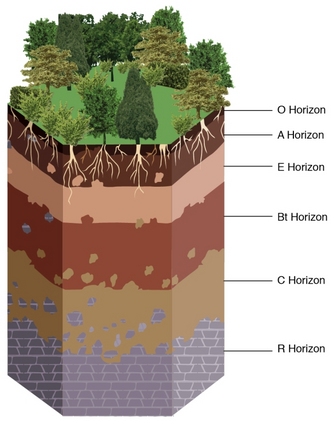
Soils are... Biological Bliss
If you like life, you'll love soils. There are a host of small, medium, and large organisms that live in soils, including mammals, birds, insects, and protozoa. But the greatest biodiversity lies in the soil microbes — the bacteria, fungi, and archaea (Figure 10). A teaspoon of rich soil can contain one billion bacteria. We actually know very little about the diversity of soil microbes, partially because they are so diverse, but also because we have not been able to culture the vast majority of these organisms in the lab. Soil microbiologists are applying advanced molecular techniques to understand the diversity and function of soil microbes. It is an exciting field of exploration with new biological taxa frequently being discovered.
Soils are... Fertile
Soils are the primary provider of nutrients and water for much of the plant life on earth. There are 18 elements considered essential for plant growth, most of which are made available to plants through root uptake from soils (Brady & Weil 2007). Soils retain nutrients by several mechanisms. Most nutrients are dissolved in soil water as either positively or negatively charged ions; soil particles are also charged and thereby are able to electrically hold these ions. Soils also hold nutrients by retaining the soil water itself.
Arguably the greatest of all the ecosystem services provided by soils is the retention of water — without soils our land would be little but rocky deserts. Plants use much more water than one might think because they are constantly releasing water into the atmosphere as a result of transpiration, which is a component of the process of photosynthesis. Clay and silt particles are the primary mineral components in soils that retain water — these small particles slow the drainage of water and, like a sponge, physically hold water through capillary forces. Clay provides such strong force that plants can't pull all the water away from it, which makes silt particles the ultimate ingredient for plant-available water storage — they hold large quantities of water but also release it to plant roots (Figure 3).
Soils are... Clay Factories
Among the most important functions performed by soils is to provide the ideal conditions for clay synthesis. Clays are important because they are often active, which is a general term soil scientists use to describe how chemically reactive a particle is with ions, water, and other particles. These reactions are critical for the provision of many ecosystem services. Clays are often the most active mineral particles because they have unique chemical characteristics and also because they have so much surface area — clays can have 10,000 times the surface area of sand of the same weight (Brady & Weil 2007). All this surface area makes clays a hot spot for chemical reactions.Soils are... Service Providers
Soils are the among the great ecosystem service providers on earth (Haygarth & Ritz 2009) (Figure 11). They store and provide water for plants. They prevent floods by transferring water slowly to streams and groundwater. They filter and remediate pollutants. They cycle and recycle nutrients and wastes — transforming them into biologically available forms, storing them away for later use, and preventing their leaching to ground and surface waters. Soils provide habitat for a vast diversity of life. They take up and release important gases, including oxygen and greenhouse gases, a service called gas regulation. Many of these ecosystem services are being lost through the degradation and loss of soils. The conservation, restoration, and optimization of ecosystem services provided by soils is among the great challenges for humanity in the 21st century.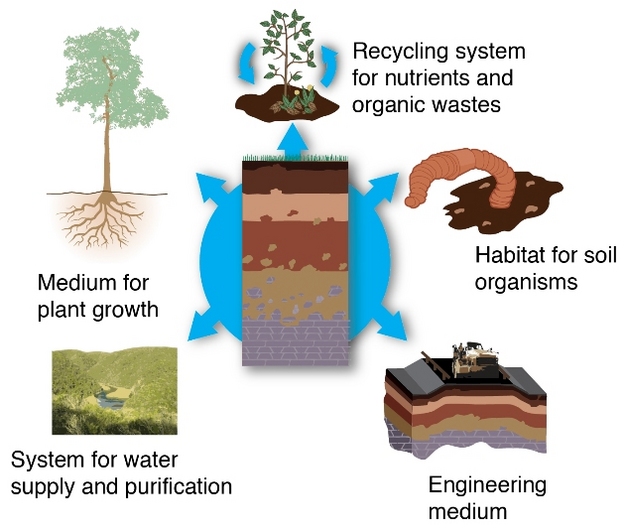
Soils are... Degrading and Polluted
Unfortunately many human activities degrade and pollute soils, lessening the ecosystem services provided by soils and making some soils and their runoff water harmful to our environment and human health. Erosion is among the great causes of soil degradation as essential topsoil is lost at rates far greater than it can be replaced (Figure 12a, 12b); this sediment is also among the greatest pollutants of water bodies. Salinization and desertification are major causes of soil degradation in arid areas. Salinization is the buildup of salts in soils to a point that they destroy the physical and chemical properties of soil and make it impossible for plants to take up water from the soil. Salinization is often associated with improper irrigation. Desertification is caused by a combination of climate changes and human-induced soil degradation (such as through overgrazing).Soils have a great capacity to filter and remediate pollutants, but applications of pollutants to soils often exceed this capacity. When we apply excess nutrients to soils, particularly nitrogen and phosphorus, we make these soils sources of nutrient pollution to water bodies. These nutrients can cause eutrophication — a process of excess algal growth that leads to oxygen depletion. We also apply many synthetic organic chemicals, metals, and radioactive materials to soils that can damage ecosystems and can have serious human health effects. The clean-up of soils is among the great efforts being conducted by soil scientists around the world.
Soils are... Home
The phrase "to be on a nation's soil" is used as a poetic means to express our connection to country, to home. Soils give us a sense of place in our environment, a sense of geography. Our language abounds with phrases such as being "grounded" and "down to earth". Although we seldom consider the role of soils in our day-to-day lives, we have an intrinsic understanding that soils are home.Soils are... a Profession
While many people work with soils — from farmers, to gardeners, to construction workers — some people make soil science a career. Soil scientists work in a variety of fields — space exploration, archeology, insurance, defense, engineering, and yes, agriculture. Soil science professional societies have been established in nations throughout the world. The Soil Science Society of America is among the largest (http://www.soils.org). Many of these organizations are represented in the International Union of Soil Sciences (http://www.iuss.org). Soil scientists are trained to understand how the basic concepts of chemistry, biology, and physics operate within the diversity of soils, and to apply this knowledge to address problems related to soil behavior and management. People drawn to this profession tend to have a love and respect for soils rooted in appreciation of their complexity, importance, and beauty.
Glossary
activity - A general term used to describe how chemically reactive a particle is with ions, water, and other particles.
clay - A mineral particle smaller than 0.002 mm.
clay synthesis - Clays are formed in soils through the transformation of existing clays or through the generation of entirely new clay particles from ions precipitating from solution.
desertification - The transformation of a non-arid landscape to an arid landscape, usually through a combination of climate changes and human-induced soil degradation.
dirt - 1. synonym for soil material; 2. soil out of place; 3. unclean material of any composition.
eluviation - The removal of materials such as clays, organic matter, iron, or aluminum from a horizon.
erosion - The surface removal of soil material from soils by the action of water or wind.
eutrophication - A process of excess algal growth that leads to oxygen depletion; often caused by excess nutrient inputs.
factors of soil formation - Factors from which soil scientists are able to predict the end result of soil formation processes: climate, organisms, topography, parent material, and time.
gas regulation - The absorption and release of gases that mediates the levels of these gases in the atmosphere.
illuviation - The deposition of materials such as clays, organic matter, iron, or aluminum into a horizon; generally the materials come from an upper horizon in the soil body.
leaching - The removal of dissolved ions from a soil.
natural bodies - Systems that form in nature with size, form, and history that act as in an integrated fashion to provide functions that differ from the sum of their parts.
remediate - To transform a chemical from a toxic form or state to a non-toxic form or state.
salinization - A build up of salts in soils to the point that they destroy the soil's physical and chemical properties and plants are not able to take up water due to the high salt concentration; often associated with improper irrigation.
sand - A mineral particle ranging in size from 0.02 to 2 mm.
silt - A mineral particle ranging in size from 0.002 to 0.02 mm.
soil - 1. A material composed of minerals, living organisms, soil organic matter, gas, and water. 2. A body composed of soil and other parts such as rocks, roots, and animals that has size, form, and history and provides integrated functions that are greater than the sum of its parts.
soil horizon - Layer present within soil bodies that are distinguishable from other layers; often generated through soil formation processes.
soil organic matter - Plant, animal, and microbial residues, in various states of decomposition.
soil texture - The percentages of sand, silt, and clay particles in a soil.
soil quality - The capacity of a soil to provide desirable ecosystem services.
transpiration - Evaporation of water from openings in plant tissues called stomata; associated with photosynthesis.
weathering - Physical, chemical, and biological processes that breakdown and transform rocks and minerals.
References and Recommended Reading
Ahrens, R. J. & Arnold, R. W. "Soil taxonomy," in Handbook of Soil Science, ed. M. Summer (CRC Press, 2000) E117-E135.
Brady, N. C. & Weil, R. R. The Nature and Properties of Soils, 14th ed. Upper Saddle River, NJ: Prentice Hall, 2008.
Food and Agriculture Organization of the United Nations (FAO). Guidelines for Soil Description, 4th ed. FAO, Rome, 2006. ftp://ftp.fao.org/docrep/fao/009/a0541e/a0541e00.pdf
Haygarth P. M. & Ritz, K. The future of soils and land use in the UK: Soil systems for the provision of land-based ecosystem services. Land Use Policy 26S:S187-S197, 2009.
Jenny, H. The Factors of Soil Formation: A System of Quantitative Pedology. New York, NY: Dover Press, 1941.
Soil Survey Division Staff. Soil Survey Manual. Soil Conservation Service, United States Department of Agriculture, Handbook 18, 1993. http://soils.usda.gov/technical/manual/



